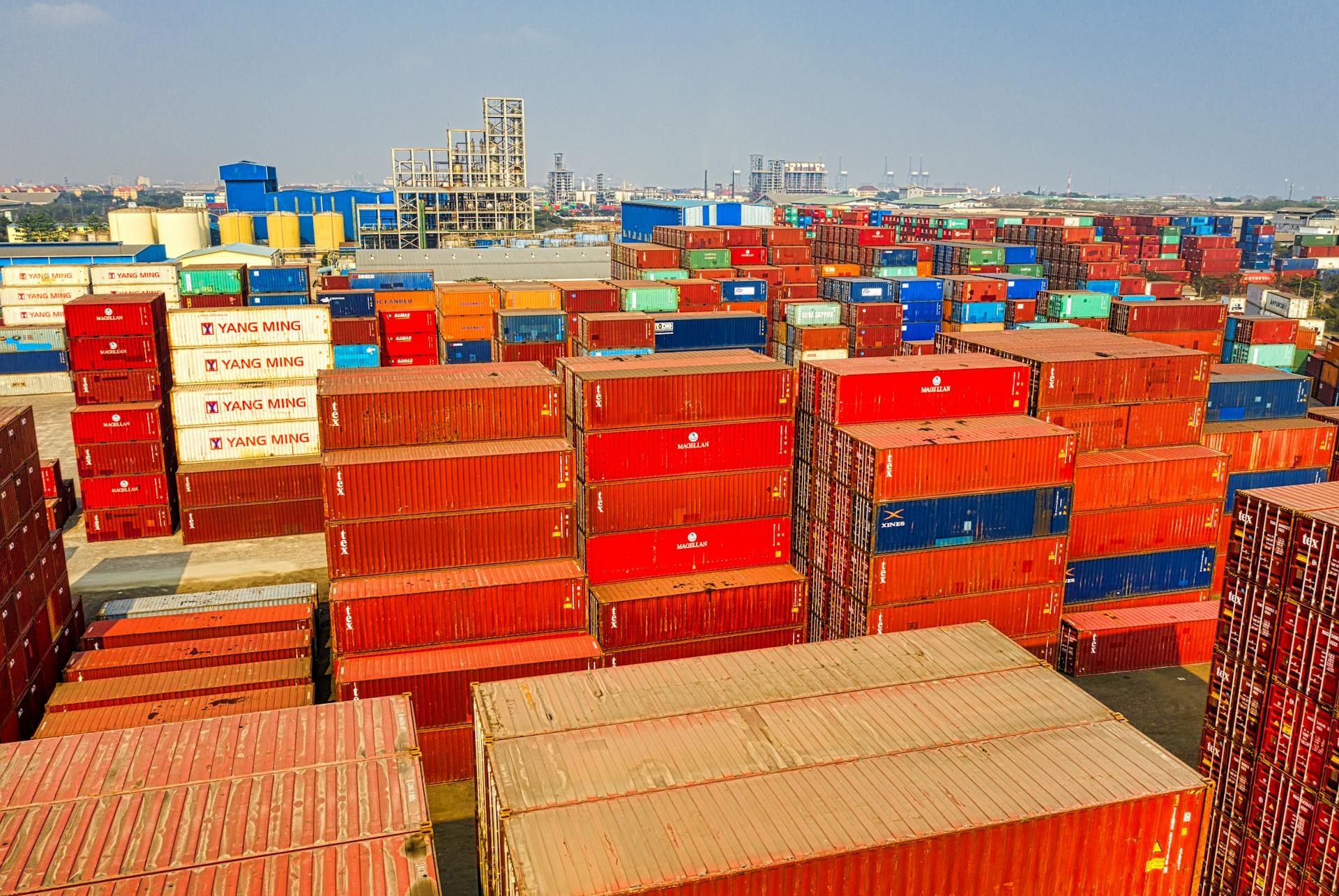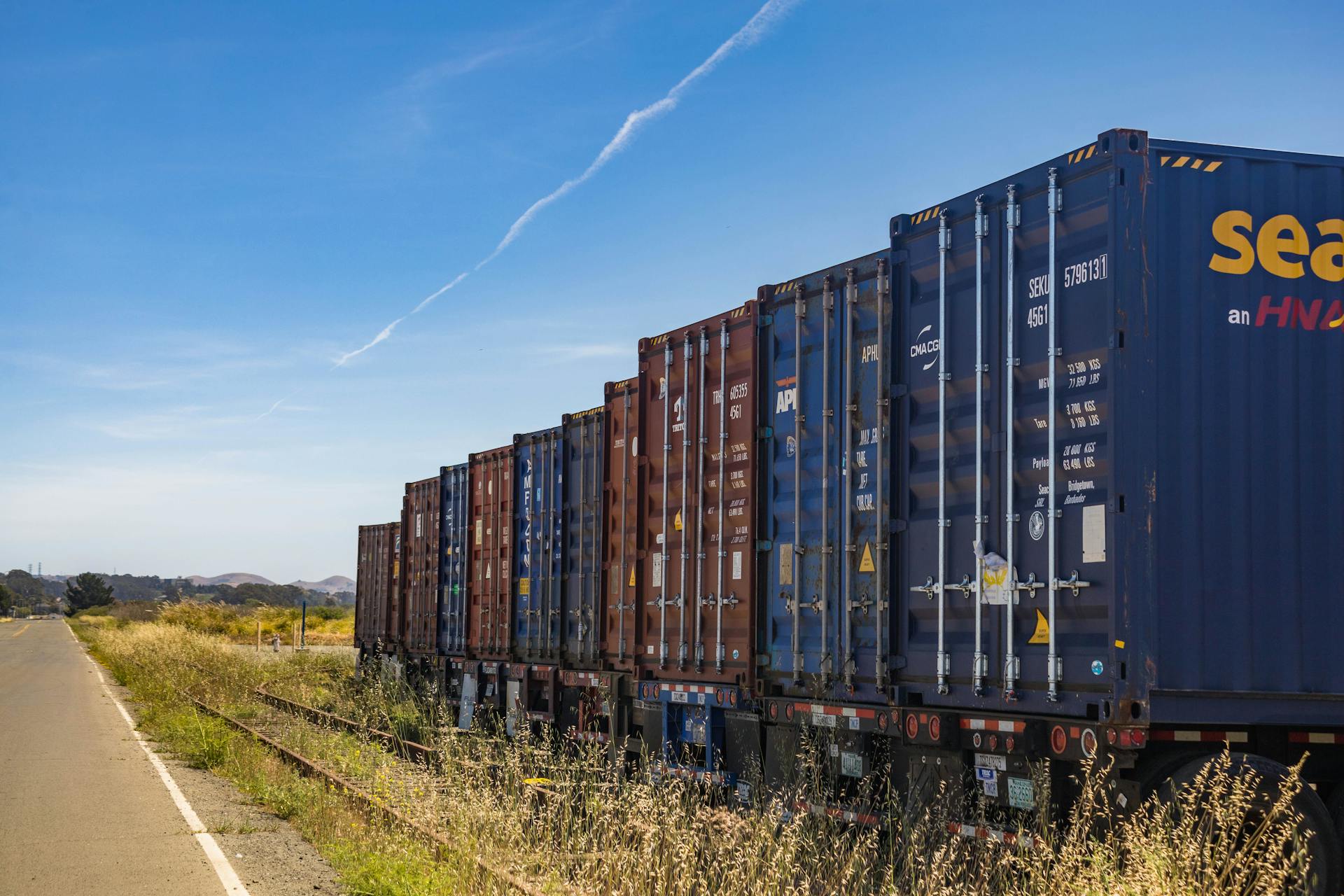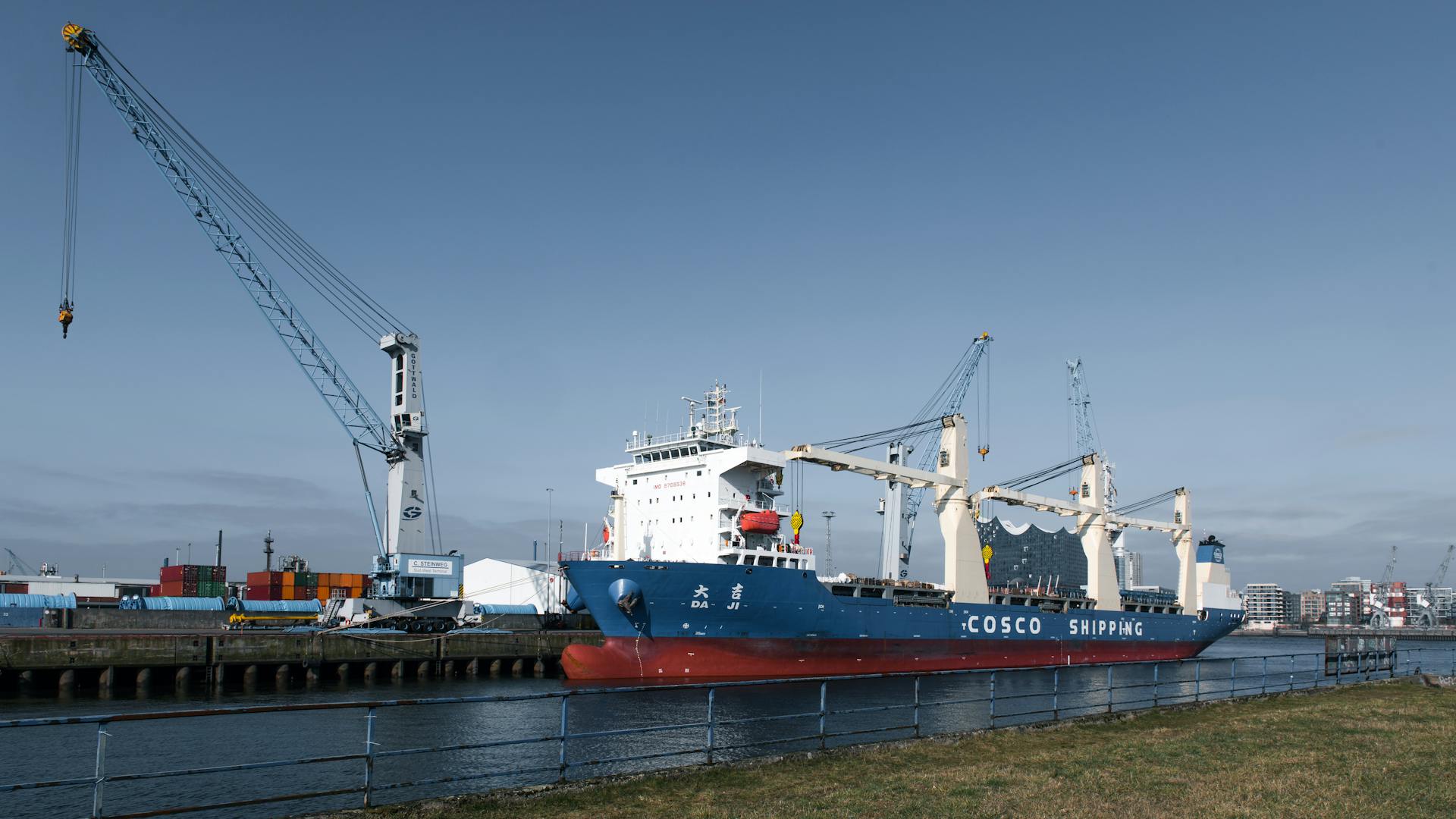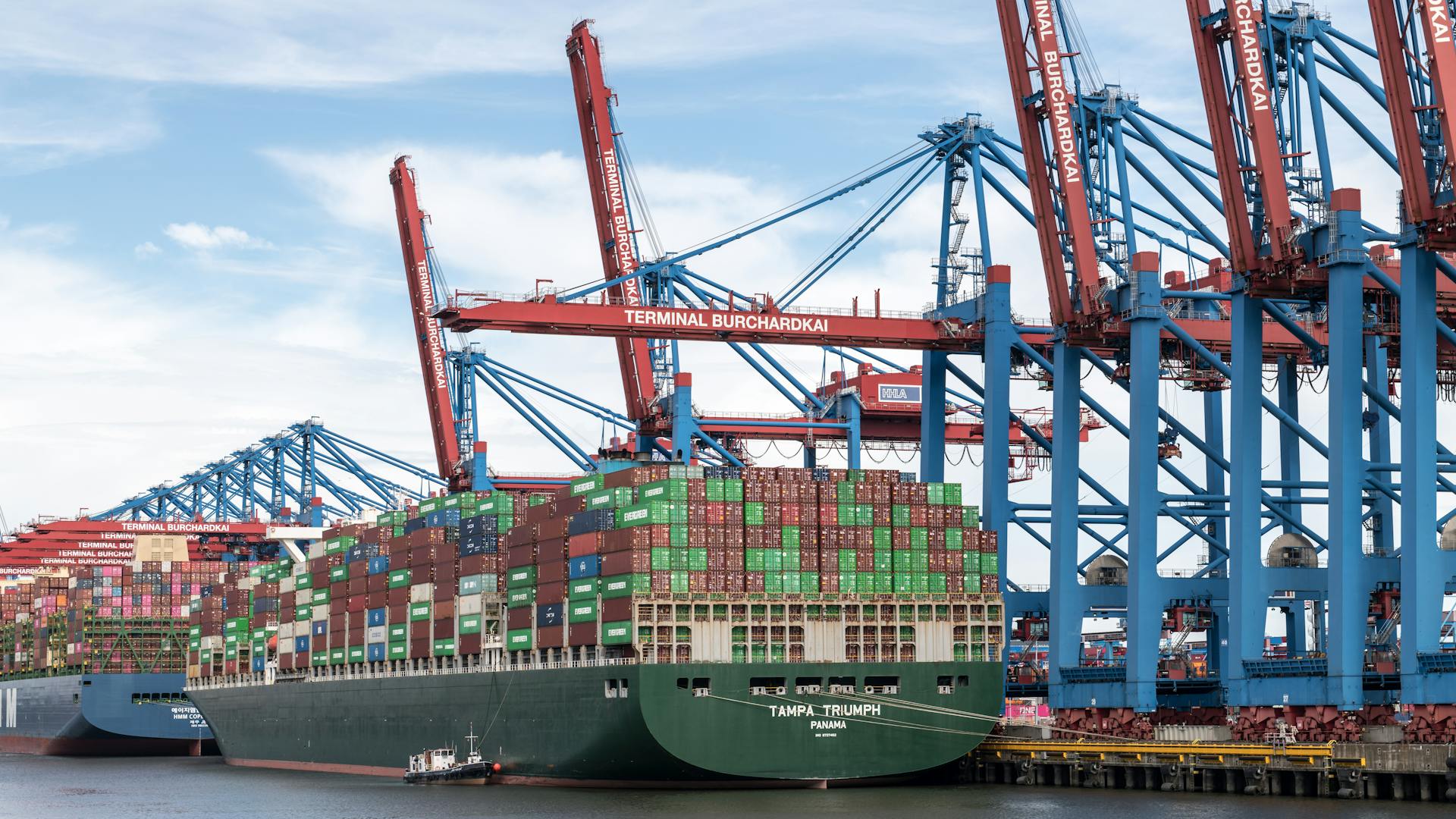
Intermodal freight transport is on the rise, with a significant increase in the use of intermodal containers. This shift towards intermodal transport is largely driven by the need for more efficient and cost-effective logistics solutions.
The use of intermodal containers has grown by 10% in the past year alone, with many major shipping lines investing heavily in their intermodal fleets. This growth is expected to continue, with forecasts predicting a 15% increase in intermodal container usage over the next five years.
One of the key benefits of intermodal transport is its reduced carbon footprint. Intermodal containers can be moved by multiple modes of transport, such as trucks, trains, and ships, which can significantly reduce greenhouse gas emissions compared to traditional trucking methods.
What Is Intermodal Freight Transport?
Intermodal freight transport is a game-changer for the logistics industry. It allows for the transportation of goods in multiple modes of transportation, such as trucks, trains, and ships, without having to reload the cargo at each transfer point.

This approach reduces transit times and costs, making it a more efficient option for businesses. In the United States, for example, intermodal freight transport accounts for over 40% of all rail freight revenue.
Intermodal freight transport relies on standardized shipping containers to facilitate the transfer of goods between different modes of transportation. These containers are designed to be easily loaded and unloaded from various types of vehicles and ships.
By using intermodal freight transport, companies can save time and money by reducing the need for multiple modes of transportation and minimizing the risk of cargo damage.
Benefits and Challenges
Intermodal freight transport offers a more efficient way to move goods, but it's not without its challenges. Understanding these hurdles can help us appreciate the complexity of the process.
The transportation of intermodal freight presents a more efficient, economical, and eco-friendly way to move goods around the world. This is a significant advantage over traditional transportation methods.
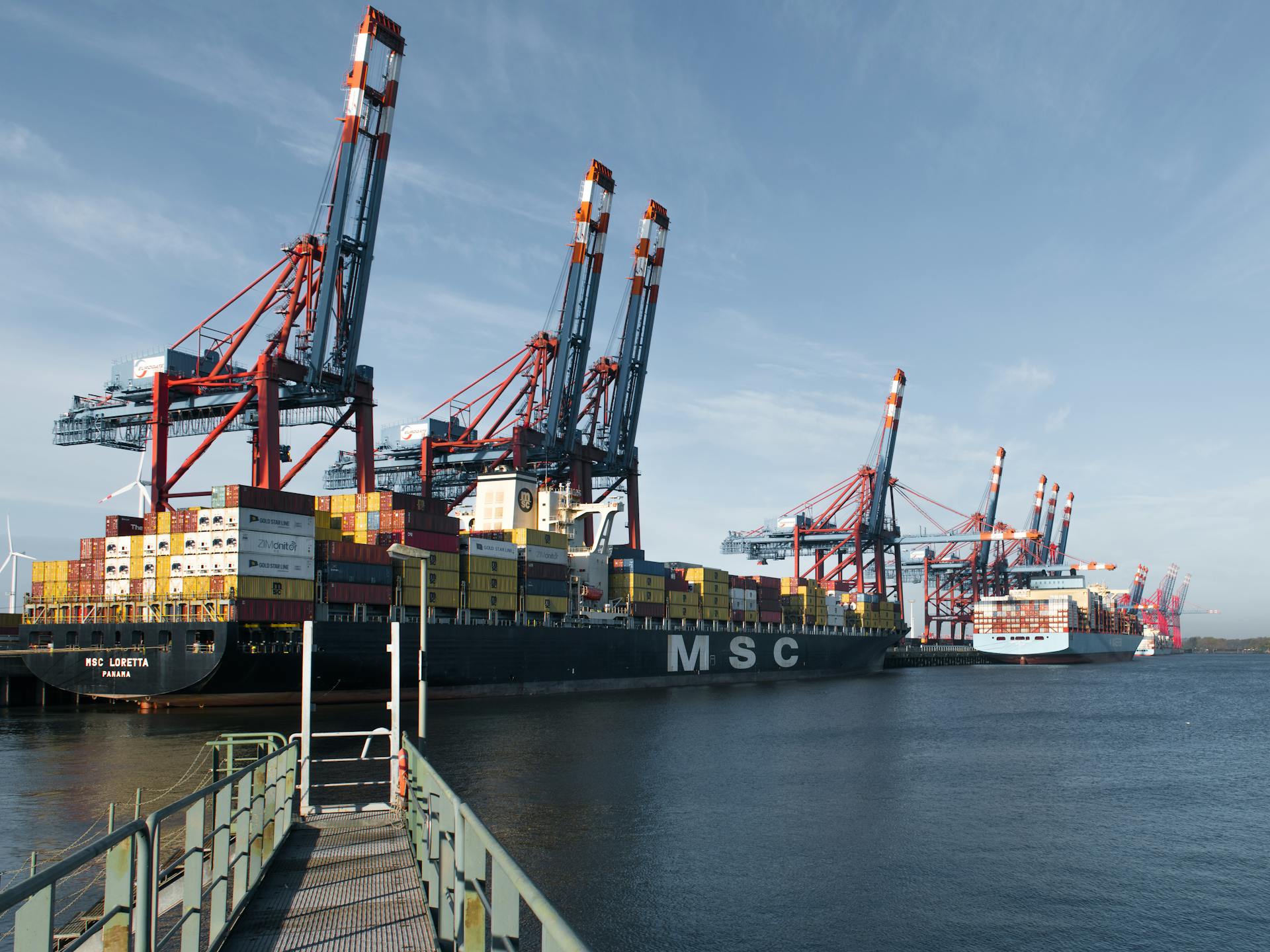
However, the efficiency and reliability of shipping can be affected by various factors, including the coordination of logistics and the movement of goods between different modes of transport. This can sometimes lead to delays and increased costs.
Intermodal transport supports a wide range of jobs, from logistics coordinators to truck drivers and port workers. This is just one of the many economic benefits of intermodal freight transport.
Challenges Faced
The transportation of intermodal freight may seem like a seamless process, but it's not without its challenges. Despite its advantages, the transportation of intermodal freight faces several challenges.
One major hurdle is the complexity of coordinating different modes of transportation, such as trains, ships, and trucks. This can lead to delays and inefficiencies.
The transportation of intermodal freight presents a more efficient, economical, and eco-friendly way to move goods around the world, but it's not without its hurdles. Understanding these challenges can help us appreciate what goes on behind the scenes every time we receive a package at our doorstep.
Another challenge is the need for specialized equipment and facilities to handle intermodal containers. This can be a significant investment for companies and can limit the adoption of intermodal freight.
Intermodal freight transportation is a more efficient and economical way to move goods, but it's not without its challenges.
Economic Benefits
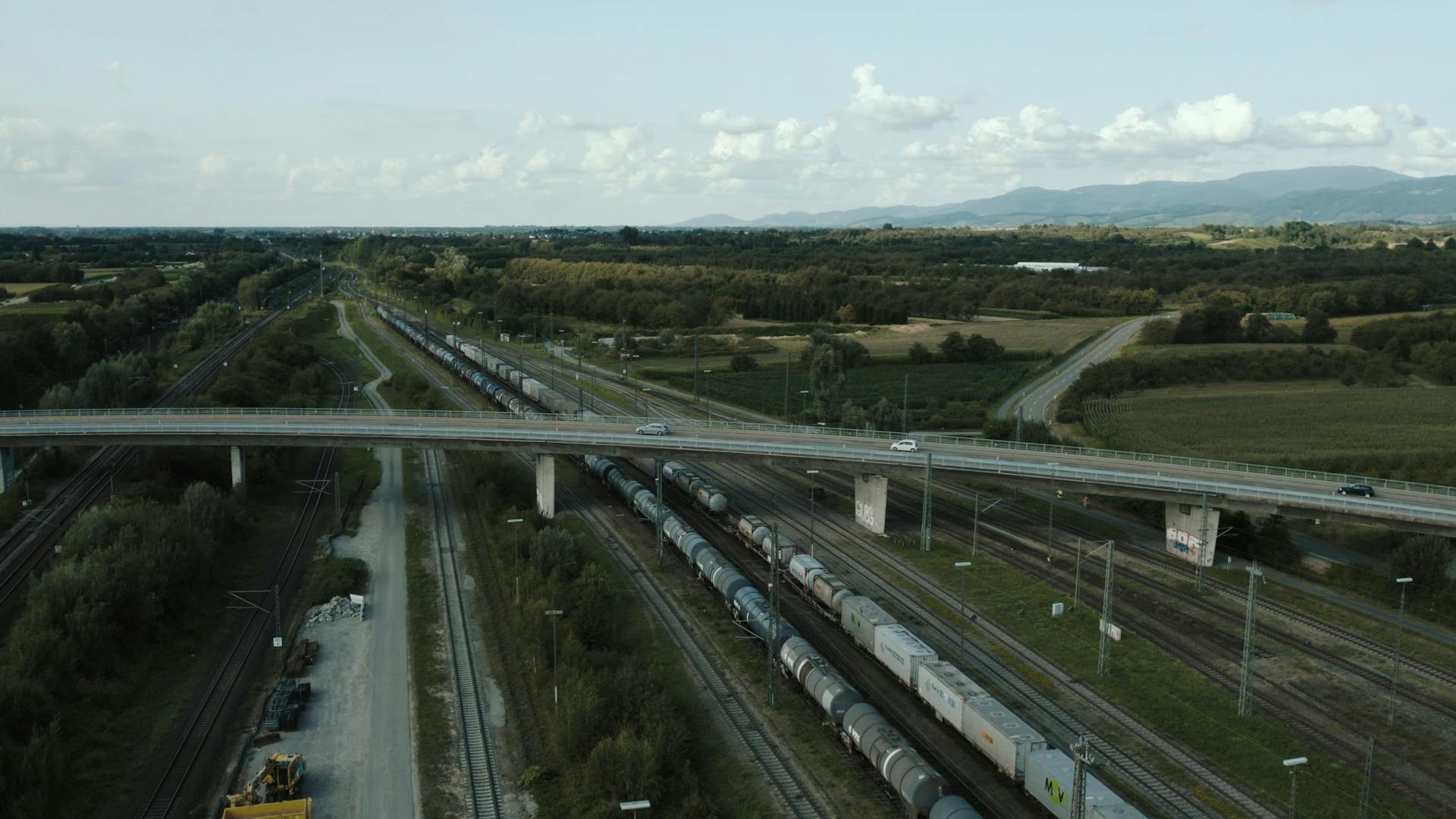
The economic benefits of intermodal transport are quite impressive. It supports a wide range of jobs, from logistics coordinators to truck drivers and port workers.
Trade between regions and countries is also enhanced, contributing to economic growth. By improving the efficiency and reliability of shipping, intermodal transport plays a significant role in this process.
Here are some key economic benefits of intermodal transport:
- Job Creation: It supports a wide range of jobs, from logistics coordinators to truck drivers and port workers.
- Trade Enhancement: By improving the efficiency and reliability of shipping, it enhances trade between regions and countries, contributing to economic growth.
Key Components and Modes
Intermodal freight transport involves multiple modes of transportation, including rail, ship, and truck. These modes work together to move goods efficiently.
Containers are a key component of intermodal transport. They're used for all transportation modes, providing a secure and standardized way to carry goods.
The flexibility of intermodal transport allows it to move goods via multiple channels. This flexibility is made possible by the different modes of transport.
Here are the modes of transport used in intermodal freight transport:
- Rail
- Ship
- Truck
Intermodal transport combines the benefits of different modes to create a suitable solution for specific types of freight and delivery. This can include quick delivery and reduced transportation costs.
Rail's Success Has a Long History

Rail's success in intermodal freight transport has a rich history that spans several decades. The modern concept of containerization began in the 1950s with the idea of moving truck-sized containers onto ships, reducing cargo handling and damage.
By the 1960s, container ships had entered widespread use, revolutionizing maritime shipping. This shift laid the groundwork for the rail industry to adapt and develop intermodal services in the 1970s.
The 1980s saw significant regulatory reforms, enabling railroads to invest heavily in intermodal infrastructure, technology, and services. This investment made freight transport more efficient, cost-effective, and adaptable.
Here's a brief timeline of the key milestones in rail's success:
- 1950s: Containerization begins with the idea of moving truck-sized containers onto ships.
- 1960s: Container ships enter widespread use, revolutionizing maritime shipping.
- 1970s: Rail and truck industries adapt to containerization, leading to the development of intermodal services.
- 1980s – 1990s: Technological advancements and globalization spur growth in intermodal freight, making it more efficient and reliable.
- 2000s – Present: Emphasis on sustainability and technology further refines intermodal transport logistics.
The 2000s and present day have seen a continued emphasis on sustainability and technology, further refining intermodal transport logistics.
Technological Innovations
Innovations in intermodal freight transport are transforming the way goods are moved across the country. Automated ports are speeding up the handling and transfer of containers, reducing downtime and costs.
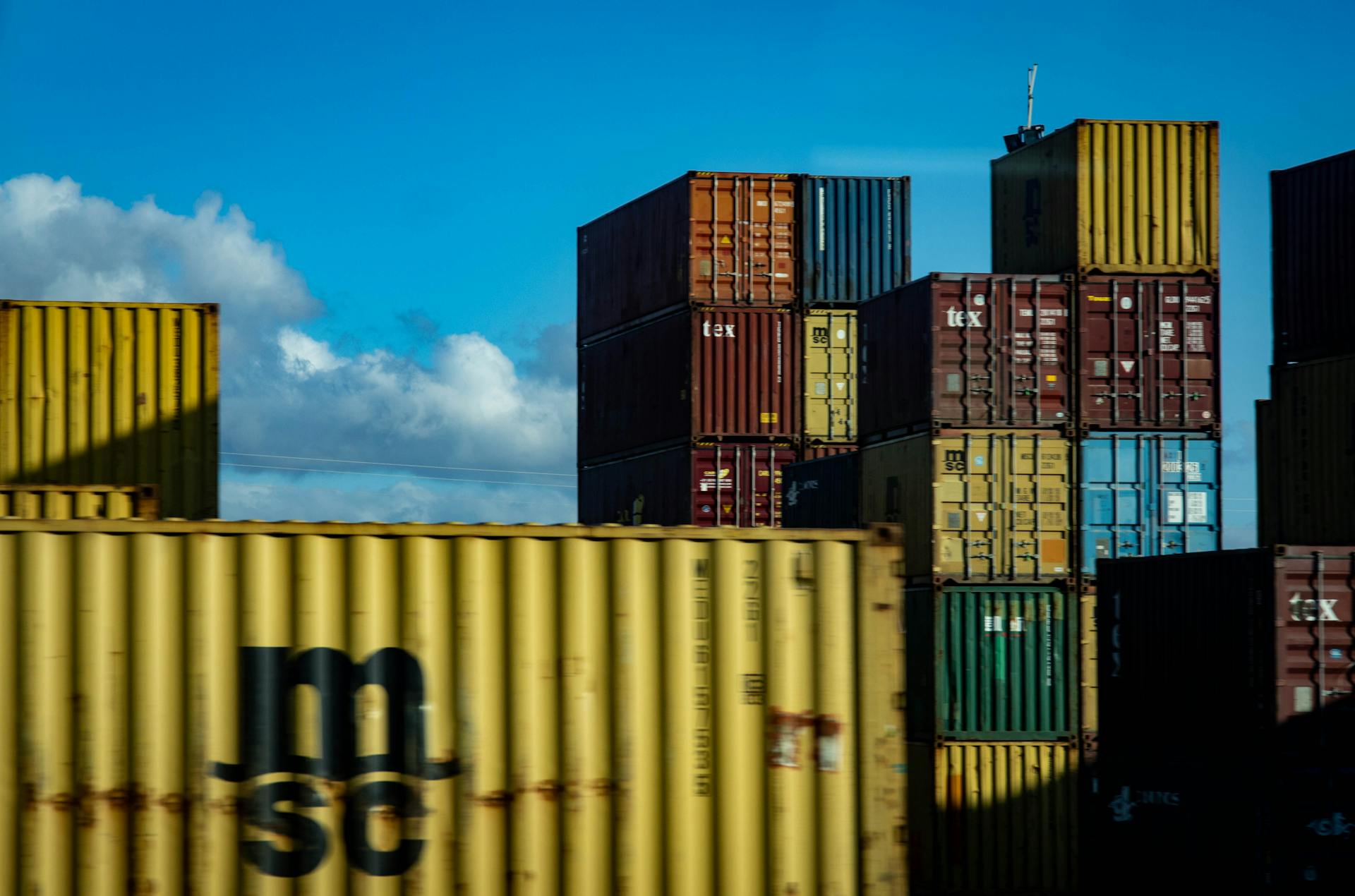
The U.S. is leading the way in adopting eco-friendly practices, such as using electric trucks for short hauls and investing in cleaner fuel technology for ships and trains. This is a significant step towards reducing the environmental impact of freight transport.
Advanced tracking technology is making the supply chain more transparent and efficient. Utilizing GPS and IoT technology, the U.S. has enhanced the tracking of cargo, making it easier to monitor shipments in real-time.
A transportation management system (TMS) can help ensure the success of your intermodal transportation by providing tracking capabilities, highlighting available carriers, and optimizing load by cost and service levels.
Here are some key technological innovations in intermodal freight transport:
- Automated ports
- Advanced tracking technology
- Green initiatives, such as electric trucks and cleaner fuel technology
- Transportation management systems (TMS)
These innovations are making intermodal freight transport faster, more reliable, and even greener. By embracing these technologies, we can create a more efficient and sustainable freight transport system.
Operational and Logistical Issues
Operational and Logistical Issues are a significant concern in intermodal freight transport. Coordinating between different modes of transport can be intricate and prone to error.
Any hiccup in one part of the transport chain can disrupt the entire schedule. Delays are a common occurrence, often caused by customs delays at ports. This can lead to a domino effect, causing further delays and increased costs.
Container imbalances can also drive up costs. This is often a result of uneven trade flows, where imports outweigh exports or vice versa, leading to an imbalance of container locations.
Intriguing read: Freight Train Container
Double Stacking
Double Stacking was a game-changer in the transportation industry. In 1977, Malcom McLean and Southern Pacific Railroad tested the first double-stacked intermodal railcar, a breakthrough that became widespread by 1980.
Double Stacking revolutionized rail container transport by increasing cargo capacity per train. This innovation made rail transport four times more fuel-efficient than trucks.
Early rail container transport was indeed inefficient due to limited cargo capacity per train. Railroads then upgraded tunnels, clearances, and tracks to accommodate these trains, which carry as much freight as hundreds of trucks.
Double Stacking has had a significant impact on reducing greenhouse gas emissions. With rail being four times more fuel-efficient than trucks, double stacking has boosted efficiency while reducing emissions.
Readers also liked: Cheap Pallet Trucks
Operational Issues
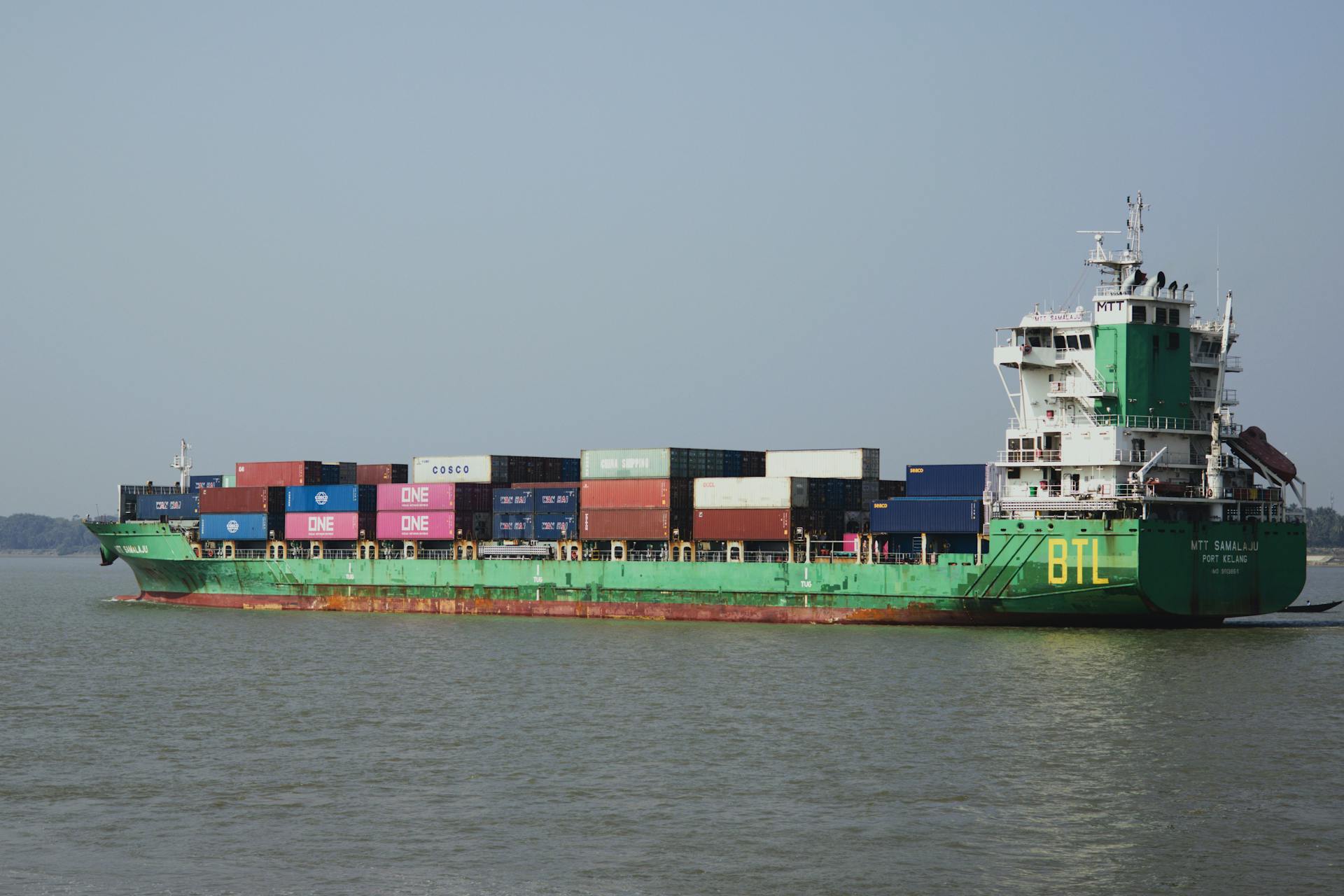
Operational Issues can be a real challenge in transportation. Coordinating between different modes of transport and handling the logistics can be intricate and prone to error.
Any hiccup in one part of the transport chain can disrupt the entire schedule, leading to delays. This can be frustrating for customers and impact business operations.
The uneven flow of trade, such as more imports than exports, or vice versa, can lead to an imbalance of container locations, driving up costs.
Here are some specific operational issues to watch out for:
- Complex Coordination
- Delays
- Container Imbalances
These issues can have a significant impact on the transportation process, making it essential to have a clear understanding of the challenges involved.
Infrastructural Issues
Infrastructural Issues can be a major headache for logistics and transportation. Aging Infrastructure is a significant problem, with many railways and ports needing upgrades to handle modern cargo loads efficiently.
In some areas, this means that transport infrastructure is struggling to keep up with demand. Limited Accessibility is also a challenge, with some regions relying heavily on trucking over long distances because they lack easy access to rail or water transport.
This can lead to congestion and delays on the roads, making it even harder to get goods where they need to go. Aging infrastructure can also increase the risk of accidents and breakdowns, which can have serious consequences for businesses and the environment.
Safety and Regulations
Safety and regulations play a crucial role in intermodal freight transport, requiring a delicate balance of procedures, precautions, and adherence to an ever-evolving regulatory landscape.
Safety in transportation is like a complex dance that requires every participant to know their steps perfectly, ensuring the show goes on without a hitch. This balance is essential to keep cargo and people safe.
Regulations are constantly evolving, which can be challenging for transport operators to keep up with. Adhering to these regulations is crucial to avoid fines and penalties.
Smooth operations across different regions and transport modes are only possible with a well-coordinated effort from all participants. This includes shippers, carriers, and logistics providers working together seamlessly.
Knowing the steps perfectly is not a one-time task; it requires continuous training and updates to stay current with the latest regulations and procedures.
Industry and Partnerships
Industry leaders are praising the Freight Logistics Optimization Works (FLOW) partnership for improving freight predictions, a crucial aspect of intermodal freight transport.
Industry partnerships are playing a key role in shaping the future of intermodal freight transport. J.B. Hunt Transport Services has recently forged a multiyear intermodal service agreement with Walmart Inc.
The partnership between J.B. Hunt and Walmart is a great example of how industry leaders are working together to improve intermodal freight transport. By leveraging technology and expertise, they can increase efficiency and reduce costs.
Here are some notable industry partnerships:
- FLOW (Freight Logistics Optimization Works) partnership
- J.B. Hunt Transport Services and Walmart Inc.
These partnerships are helping to drive innovation and growth in the intermodal freight transport industry.
Global Landscape
The global landscape of intermodal freight transportation is a complex and ever-evolving network. The United States plays a leading role in this global network, guiding trends and setting standards.
Intermodal transport is a key player in reducing the carbon footprint of global trade. By utilizing trains and ships that are more fuel-efficient over long distances compared to trucks, intermodal transport is helping to make global trade more sustainable.
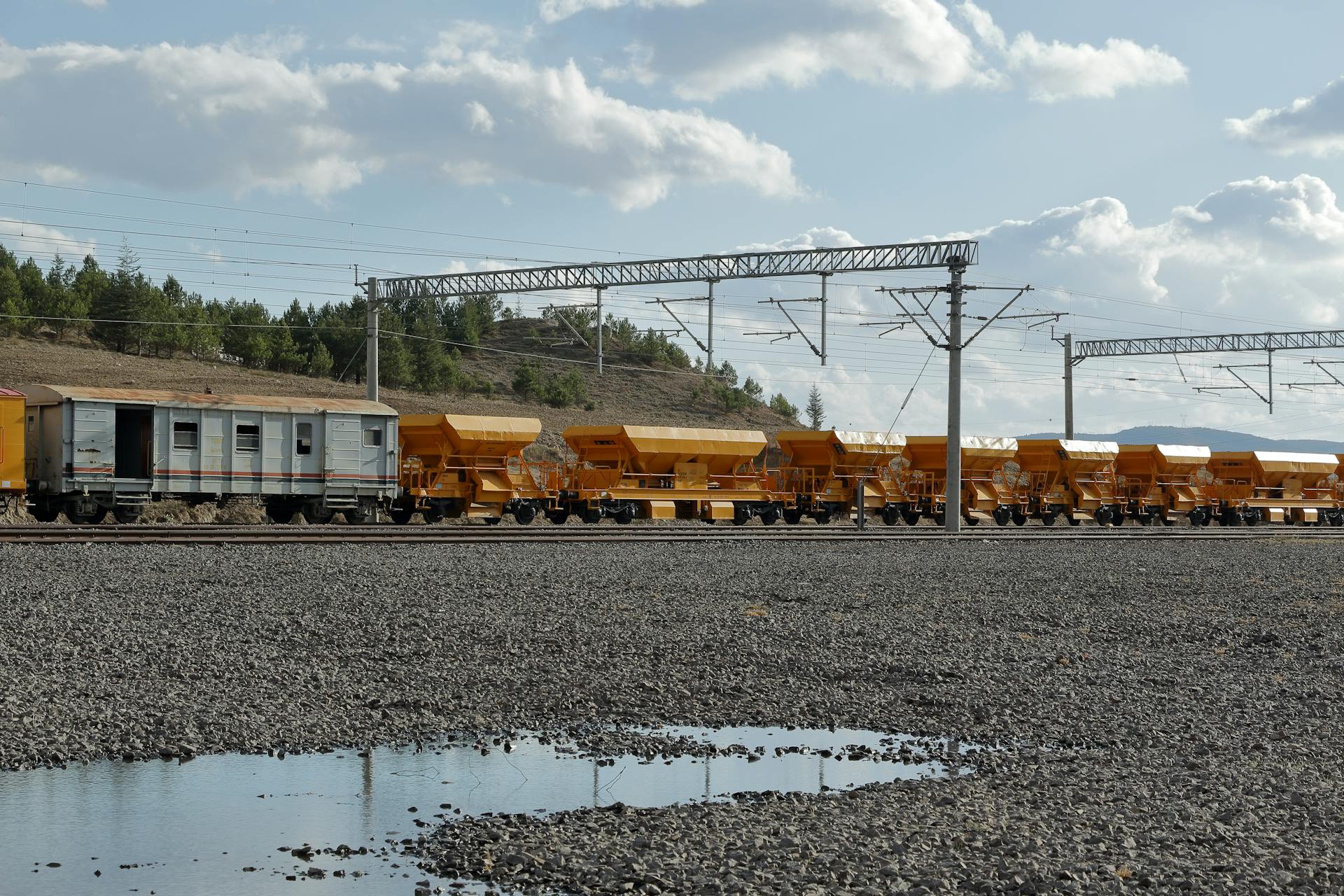
The use of technology is also playing a crucial role in improving the efficiency and security of intermodal transport. GPS and blockchain are just a couple of examples of the innovative tools being used to track goods and ensure their secure handling across borders.
Here are some of the key trends shaping the global landscape of intermodal freight transportation:
- Sustainability and eco-friendliness: Intermodal transport reduces carbon footprint by using fuel-efficient trains and ships.
- Technological advancements: GPS and blockchain improve efficiency and security of intermodal transport.
- Increased urbanization: Efficient intermodal systems are crucial for urban logistics as more people move to cities.
Industry and Partnerships
J.B. Hunt Transport Services has entered into a multiyear intermodal service agreement with Walmart Inc. This partnership highlights the growing importance of intermodal transportation in the logistics industry.
Norfolk Southern has created a DRIVE Team to improve terminal operations and partner communication, focusing on enhancing safety and efficiency at intermodal terminals.
Railroads have invested billions in expanding intermodal terminals, adding advanced equipment like GPS-enabled cranes for quick transfers. Over 180 intermodal terminals exist in the U.S., making rail a competitive option for domestic freight.
Intermodal transportation is becoming increasingly popular, with companies like Walmart and J.B. Hunt partnering with railroads to improve efficiency and reduce costs.
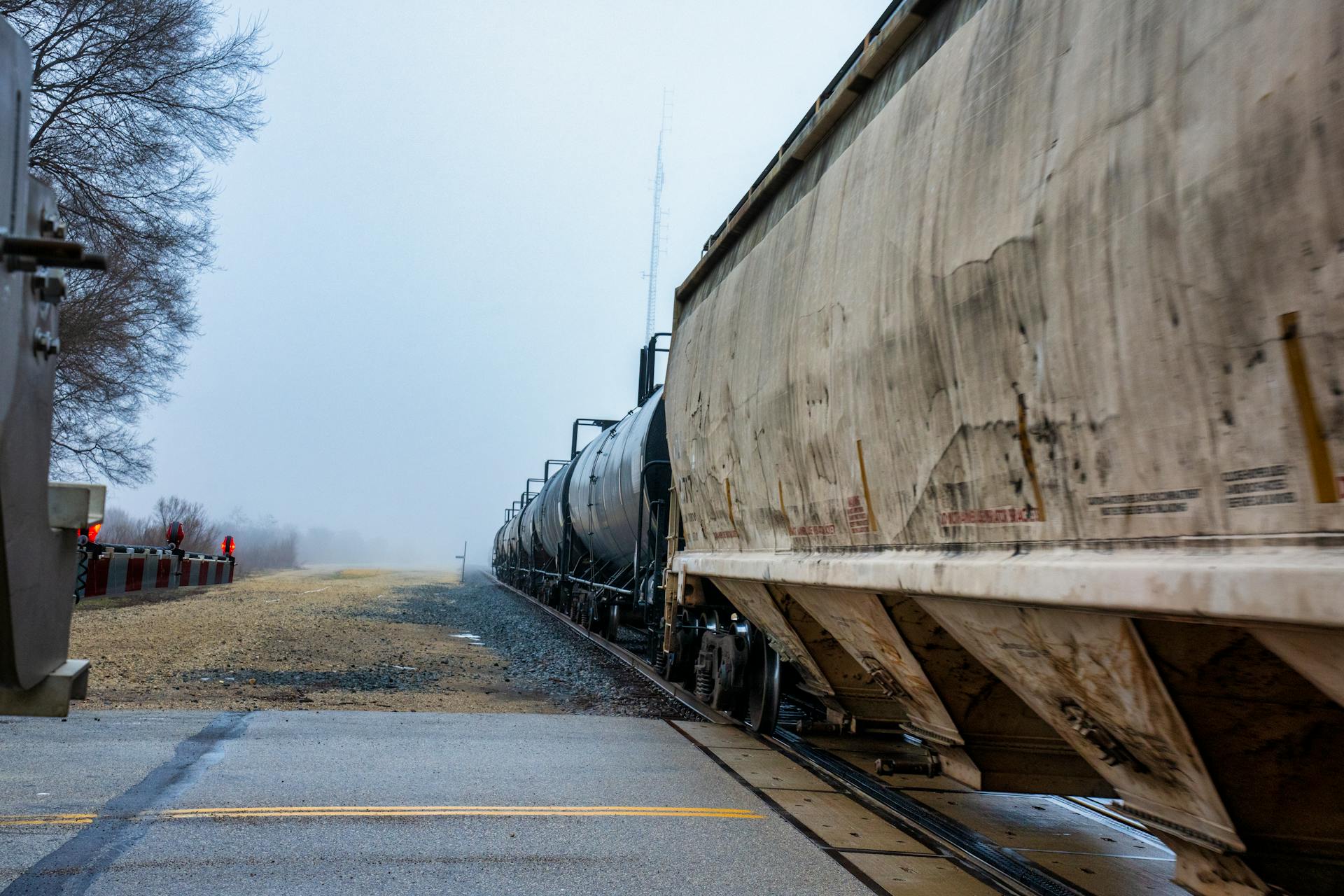
Here are some key partnerships in the intermodal industry:
The growth of intermodal transportation is driven by its environmental benefits, with trains and ships being more fuel-efficient over long distances compared to trucks.
Industry Leaders Praise FLOW for Improved Predictions
Industry leaders are singing the praises of FLOW, a public-private partnership that's making a real difference in freight predictions. The FLOW partnership is helping to overcome the challenge of forecasting freight congestion, according to industry experts.
Industry experts, including those who attended the 2024 IANA Expo, are impressed with the results of the FLOW partnership. They recognize the value of improved freight predictions in keeping supply chains running smoothly.
FLOW's success is a testament to the power of collaboration between the public and private sectors. By working together, organizations can achieve more than they could alone.
Strategies and Best Practices
To optimize your intermodal freight transport, consider flexible scheduling. Don't stick rigidly to timetables, as adapting your schedule can optimize transportation usage.
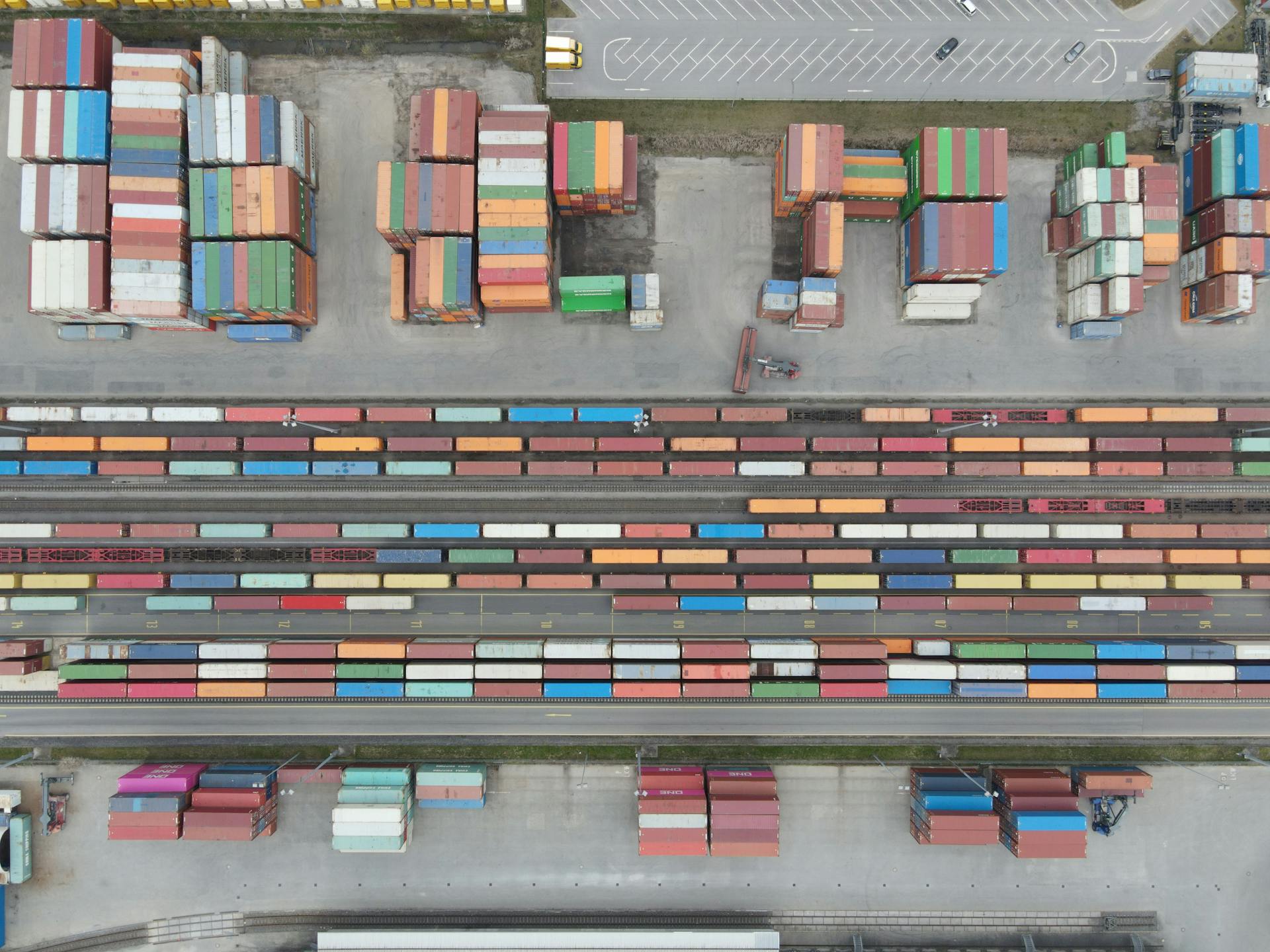
Adapting to changing circumstances is crucial in intermodal transport. This method teaches us to be versatile, which can lead to more efficient use of resources.
If you're looking for ways to reduce your environmental impact, consider providers that use green technologies. They're not just good for the environment; they can also lead to cost savings in the long run.
Here are some key strategies to keep in mind:
- Flexible scheduling can help optimize transportation usage.
- Green technologies can lead to cost savings and reduce environmental impact.
Protecting cargo integrity is also essential in intermodal freight transport. A cargo integrity plan can help reduce the risk of supply chain disruptions.
See what others are reading: High Value Cargo Transportation
Sustainability and Cost-Effectiveness
Intermodal freight transport is a game-changer for sustainability and cost-effectiveness. By optimizing the transportation process, it offers a significant cost-advantage.
Moving goods in bulk via rail or ship reduces costs significantly when compared to long-haul trucking. This is especially true for large shipments that can take advantage of economies of scale.
The standardized use of containers means goods don't need to be unloaded and reloaded at each transfer point, saving on handling costs. This streamlined process not only saves time but also reduces the risk of damage or loss during transit.
You might enjoy: Freight on Board Cost
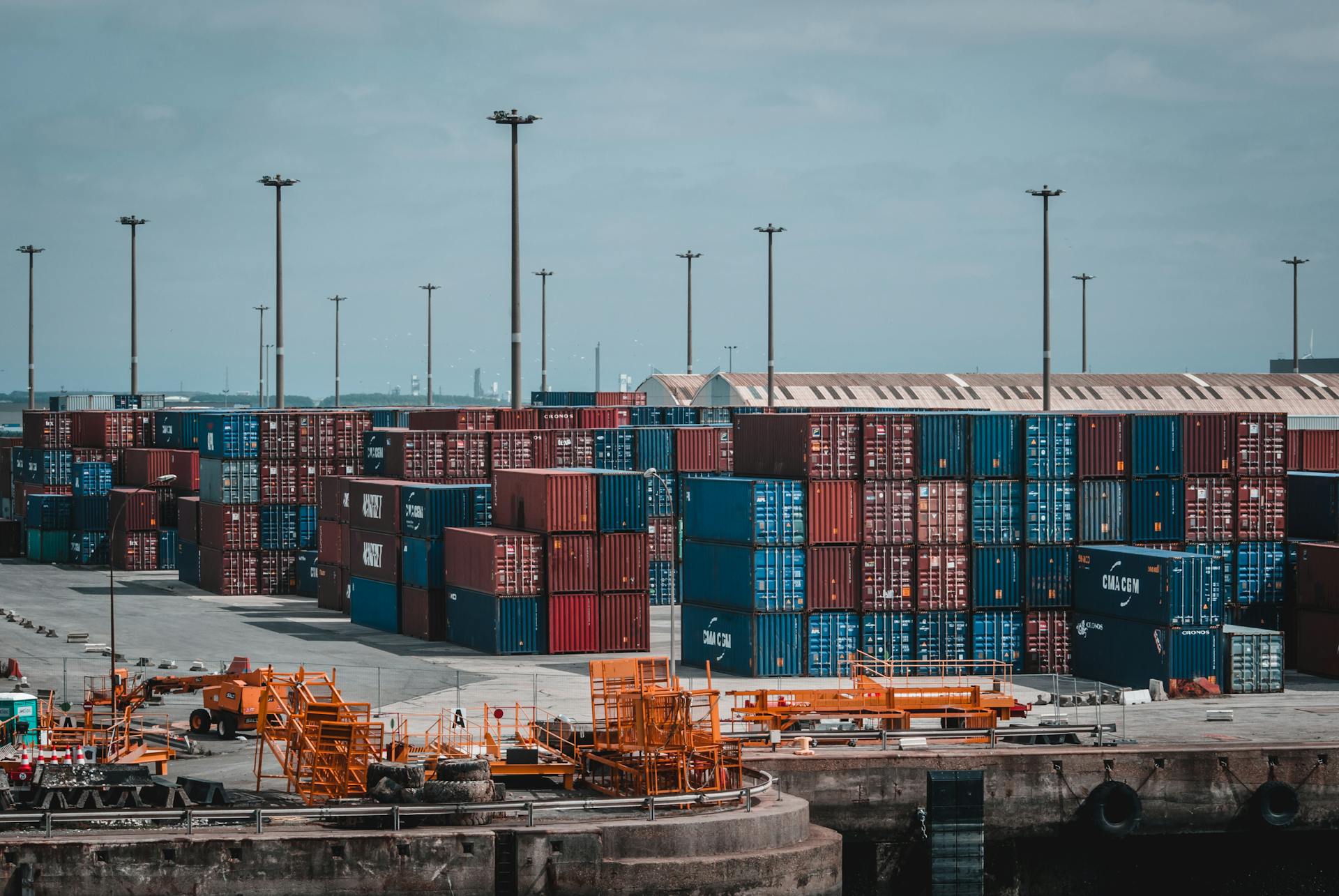
Here are some key benefits of intermodal transport:
- Bulk Movement: Moving goods in bulk via rail or ship reduces costs significantly.
- Lowered Handling Costs: The standardized use of containers means goods don’t need to be unloaded and reloaded at each transfer point.
By choosing intermodal transport, businesses can make a positive impact on the environment while also saving money.
News and Updates
There's a growing trend towards sustainability in intermodal transport, with a focus on reducing carbon footprints. Intermodal transport is becoming more popular due to its fuel-efficient nature, especially when using trains and ships over long distances.
Globalization is driving the demand for efficient intermodal systems, particularly in urban areas. As more people move to cities, the complexity of delivering goods increases, making efficient intermodal systems crucial for urban logistics.
Technological advancements are improving the efficiency and security of intermodal transport. GPS and blockchain are being used to track goods and ensure they're handled efficiently across borders.
Norfolk Southern is adopting updates to the Switching and Absorption Tariff 8001-A, effective May 3, 2025. Please check the Intermodal Rules Circular for more information.
Here are some key global trends in intermodal transport:
- Sustainability and eco-friendliness: Intermodal transport reduces carbon footprints by utilizing fuel-efficient trains and ships.
- Technological advancements: GPS and blockchain improve efficiency and security by tracking goods and handling them efficiently across borders.
- Increased urbanization: Efficient intermodal systems are crucial for urban logistics as more people move to cities, increasing the complexity of delivering goods.
Frequently Asked Questions
Who is the largest intermodal trucking company?
J.B. Hunt is the largest intermodal trucking company in North America, offering a wide range of shipping solutions. Learn more about the value of shipping with J.B. Hunt.
What is the future of intermodal transportation?
The global intermodal transportation market is expected to experience rapid growth, expanding from $55.3 billion in 2022 to $197.59 billion by 2032. This significant increase is driven by a compound annual growth rate of 15.2%, indicating a bright future for intermodal transportation.
Sources
- https://www.joc.com/surface/rail-news/intermodal-providers
- https://www.ttnews.com/categories/intermodal-0
- https://www.joc.com/surface/rail-news
- https://www.aar.org/issue/freight-rail-intermodal/
- https://www.rsilogistics.com/blog/mastering-the-transportation-of-intermodal-freight/
- https://www.norfolksouthern.com/en/ship-by-rail/industry/intermodal
- https://www.plslogistics.com/blog/benefits-of-intermodal-transportation/
Featured Images: pexels.com
